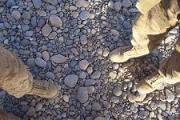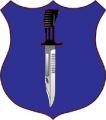THE order of battle is that division and formation of the different arms into separate parts or sections of the whole Army, and that form of general position or disposition of those parts which is to be the norm throughout the whole campaign or war.
........
The greater armies become, the more they are distributed over wide spaces and the more diversified the action and reaction of the different parts amongst themselves, the wider becomes the field of strategy, and, therefore, then the order of battle, in the sense of our definition, m
ust also come into a kind of reciprocal action with strategy, which manifests itself chiefly at the extreme points where tactics and strategy meet, that is, at those moments when the general distribution of the combatant forces passes into the special dispositions for the combat.
We now turn to those three points, the division, combination of arms, and order of battle (disposition) in a strategic point of view.
1.—Division.
In strategy we must never ask what is to be the strength of a division or a corps, but how many corps or division an army should have (
or how many sections or teams a platoon should have.) There is nothing more unmanageable than an army divided into three parts, except it be one divided into only two, in which case the chief command must be almost neutralised.
To fix the strength of great and small corps, either on the grounds of elementary tactics or on higher grounds, leaves an incredibly wide field for arbitrary judgment, and heaven knows what strange modes of reasoning have sported in this wide field. On the other hand, the necessity of forming an independent whole (army) into a certain number of parts is a thing as obvious as it is positive, and this idea furnishes real strategic motives for determining the number of the greater divisions of an army, consequently their strength, whilst the strength of the smaller divisions, such as companies, battalions, etc., is left to be determined by tactics.
.....
Certainly it seems that the supreme direction of an army (and the direction of every whole) must be greatly facilitated if there are only three or four subordinates to command, but the commander-in-chief must pay dearly for this convenience in a twofold manner. In the first place, an order loses in rapidity, force, and exactness if the gradation ladder down which it has to descend is long, and this must be the case if there are corps-commanders between the division leaders and the chief; secondly, the chief loses generally in his own proper power and efficiency the wider the spheres of action of his immediate subordinates become.
........
But on the other hand the number of divisions must not be too great, otherwise disorder will ensue. It is difficult enough to manage eight divisions from one head quarter, and the number should never be allowed to exceed ten. But in a division in which the means of circulating orders are much less, the smaller normal number four, or at most five, may be regarded as the more suitable.
If these factors, five and ten, will not answer, that is, if the brigades are too strong, then corps d'armée must be introduced; but we must remember that by so doing, a new power is created, which at once very much lowers all other factors.
........
This is the abstract view of the case. The particular case may present good reasons for deciding otherwise. Likewise, we must admit that, although eight or ten divisions may be directed when united in a level country, in widely extended mountain positions the thing might perhaps be impossible. A great river which divides an army into halves, makes a commander for each half indispensable; in short, there are a hundred local and particular objects of the most decisive character, before which all rules must give way.
But still, experience teaches us, that these abstract grounds come most frequently into use and are seldomer overruled by others than we should perhaps suppose.
We wish further to explain clearly the scope of the foregoing considerations by a simple outline, for which purpose we now place the different points of most importance next to each other.
As we mean by the term numbers, or parts of a whole, only those which are made by the primary, therefore the immediate division, we say.
1. If a whole has too few members it is unwieldy.
2. If the parts of a whole body are too large, the power of the superior will is thereby weakened.
3. With every additional step through which an order has to pass, it is weakened in two ways: in one way by the loss of force, which it suffers in its passage through an additional step; in another way by the longer time in its transmission.
The tendency of all this is to show that the number of co-ordinate divisions should be as great, and the gradational steps as few as possible; and the only limitation to this conclusion is, that in armies no more than from eight to ten, and in subordinate corps no more than from four or at most six, subdivisions can be conveniently directed.
(
When thinking about platoons and their divisions/teams one can see that this points seems to be still of value
2.—Combination of Arms.
For strategy the combination of the three arms in the order of battle is only important in regard to those parts of the army which, according to the usual order of things, are likely to be frequently employed in a detached position, where they may be obliged to engage in an independent combat. Now it is in the nature of things, that the members of the first class, and for the most part only these, are destined for detached positions, because, as we shall see elsewhere, detached positions are most generally adopted upon the supposition and the necessity of a body independent in itself.
In a strict sense strategy would therefore only require a permanent combination of arms in army corps, or where these do not exist, in divisions, leaving it to circumstances to determine when a provisional combination of the three arms shall be made in subdivisions of an inferior order.
But it is easy to see that, when corps are of considerable size, such as 30,000 or 40,000 men, they can seldom find themselves in a situation to take up a completely connected position in mass. With corps of such strength, a combination of the arms in the divisions is therefore necessary.
No one who has had any experience in war, will treat lightly the delay which occurs when pressing messages have to be sent to some other perhaps distant point before cavalry can be brought to the support of infantry—to say nothing of the confusion which takes place. (
the friction at work, and a case for organic combination of arms
The details of the combination of the three arms, how far it should extend, how low down it should be carried, what proportions should be observed, the strength of the reserves of each to be set apart—these are all purely tactical considerations.
3.—The Disposition.
The determination as to the relations in space, according to which the parts of an army amongst themselves are to be drawn up in order of battle, is likewise completely a tactical subject, referring solely to the battle. No doubt there is also a strategic disposition of the parts; but it depends almost entirely on determinations and requirements of the moment, and what there is in it of the rational, does not come within the meaning of the term "order of battle." We shall therefore treat of it in the following chapter under the head of Disposition of an Army.
The order of battle of an army is therefore the organisation and disposition of it in mass ready prepared for battle. Its parts are united in such a manner that both the tactical and strategical requirements of the moment can be easily satisfied by the employment of single parts drawn from the general mass. When such momentary exigency has passed over, these parts resume their original place, and thus the order of battle becomes the first step to, and principal foundation of, that wholesome methodicism which, like the beat of a pendulum, regulates the work in war, and of which we have already spoken in the fourth chapter of the Second Book.







 ). Good news is I still have my striped shirt.
). Good news is I still have my striped shirt.

 )
)
 ) I really marvelled at this level of knowledge, (and skill) but I always came back to, "shouldn't most soldiers be able to do this?"
) I really marvelled at this level of knowledge, (and skill) but I always came back to, "shouldn't most soldiers be able to do this?"




Bookmarks